In the Moment:
Michael Frye's Landscape Photography Blog
by Michael Frye | Dec 31, 2024 | Announcements
Happy New Year! Once again I’m inviting you, my faithful blog readers, to help me choose my best photographs from the past year. I’ve posted 45 of my favorite images from 2024 below, in chronological order. After you look through these, please use the form at the bottom of this post to list your ten favorites.
The voting deadline is midnight Pacific Time this Saturday, January 4th. Voting has closed.
You don’t have to list your ten favorites in any order; just pick up to ten images. Once the votes are in I’ll post the top ten or twelve on this blog. (The number for each photo is in the caption underneath the photograph. Also, you can click on the images to see them larger.)
As always, I reserve the right to override the votes if one of my favorites gets panned. But I’ve rarely had to exercise this power because my readers have excellent taste. 🙂
Thanks for your input — I appreciate your help!
(more…)
by Michael Frye | Dec 29, 2024 | Light and Weather
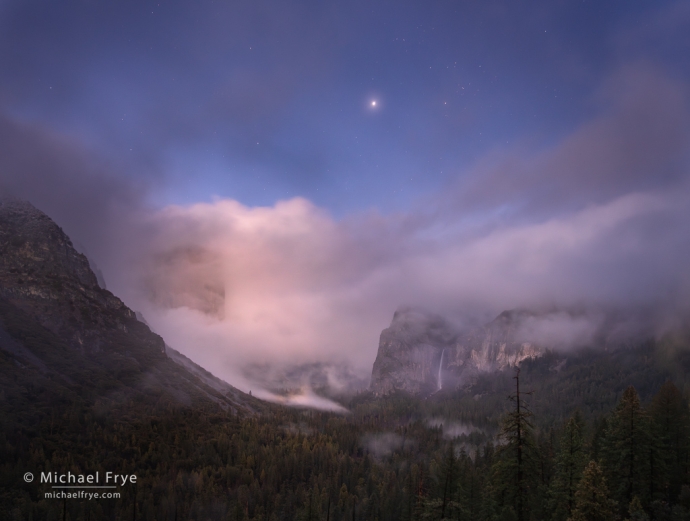
Yosemite Valley at dusk with stars and Jupiter, Yosemite NP, California. This storm cleared just after sunset. It was dark enough for stars to appear, but with a post-sunset glow still lingering on El Capitan. 25mm, 10 seconds at f/4, ISO 2000.
We’ve stayed close to home this month, but I’ve been making lots of photographs. I previously posted photos of fog in the foothills, and ice in Yosemite. But I’ve also been able to photograph Yosemite with clearing storms, and mist, and a moonrise, and with just ordinary, beautiful winter light.
Yosemite Valley is small – only seven square miles. This tiny area is renowned for its grand scenery, but it also contains a wonderful variety of beautiful details and intimate landscapes. No matter how many times I go back, I always find new things to photograph – or find that the same spots look new, and different, under different conditions. There’s always something to photograph there, if I look.
(more…)
by Michael Frye | Dec 24, 2024 | Announcements
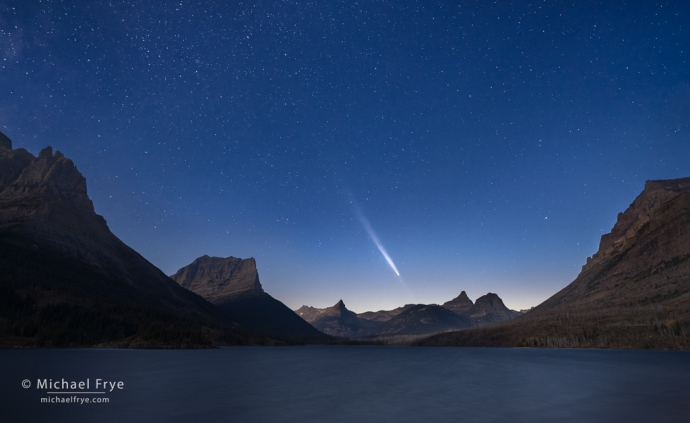
Comet Tsuchinshan-Atlas over St. Mary Lake, Glacier NP, Montana
I made this photograph of Comet Tsuchinshan-Atlas back in October, in Glacier National Park, just after the amazing auroral event we watched there. I haven’t had a chance to post this image before, but it seemed appropriate for the season, both for its symbolism, and because this celestial object evokes (at least for me) feelings of joy, wonder, awe, and mystery. We live in an incredible universe, and I feel lucky to experience its wonders every day.
Claudia and I wish you a very Merry Christmas and a Happy Hanukkah! We hope you have a beautiful holiday, full of peace, joy, wonder, and the love of family and friends.
— Michael Frye
by Michael Frye | Dec 22, 2024 | Light and Weather
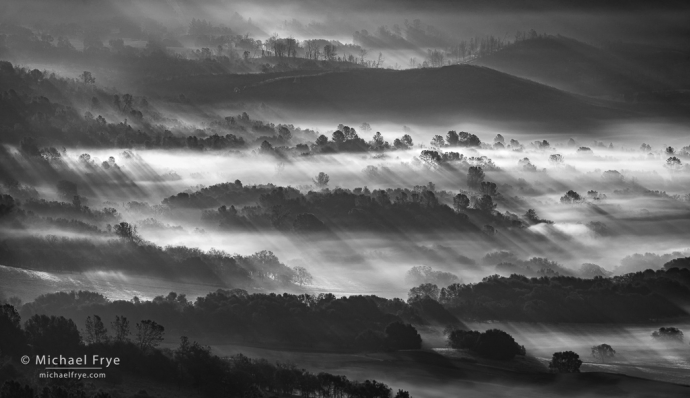
Fog and sunbeams, Sierra Nevada foothills, California. I made this image Wednesday morning, after the sun rose high enough to rake across these layers of fog and trees. In color it was all one note, with everything a pale gold color. Since it was monochromatic anyway, I tried it in black and white, and liked that much better. I think the color distracted from the main story of the photograph, which is about the layers, patterns of light and dark, and tree shadows. 321mm, 1/200 sec. at f/11, ISO 100.
California’s Central Valley is often filled with fog in winter. Usually a shallow layer of fog forms during the night, then burns off the next morning as the sun warms the air. There’s a temporary, low-level inversion during the night and early morning, where the air near the ground is cooler than the air higher up, but when the sun penetrates the fog and warms the ground the inversion ends.
Sometimes, however, the fog in the Central Valley is so thick it doesn’t burn off. The weak sunlight on short winter days never penetrates the fog layer completely, so the fog lasts all day, and into the next night. If the fog persists for a couple of days the inversion will grow deeper (it can get up to two- or three-thousand feet deep), and the fog will gradually lift off the ground into a low overcast, or stratus deck. And then that higher-altitude fog layer will push up into the Sierra foothills. A stratus deck like this can last for several days, or even a week, until a disturbance in the atmosphere (like a storm, or even a weak, dry front) mixes the air and ends the inversion.
(more…)
by Michael Frye | Dec 15, 2024 | Advanced Techniques, Composition
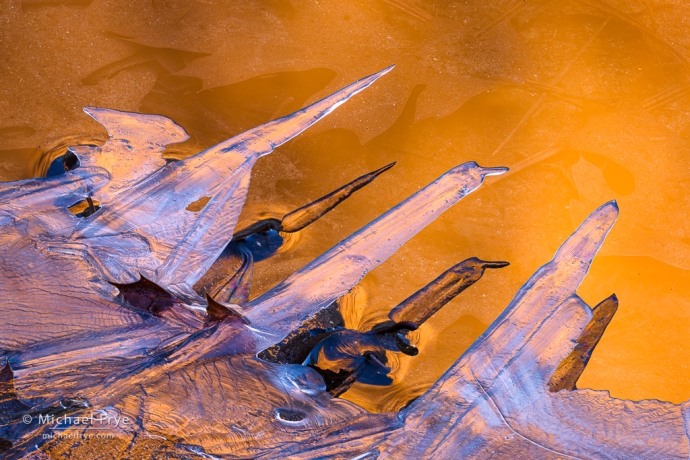
Ice fingers, Yosemite NP, California. 400mm, 1 second at f/16, ISO 100; 18 focus-stacked frames blended with Helicon Focus Pro. I needed to photograph this detail at an angle to get the orange reflections, requiring focus-stacking to get everything sharp. (It’s a reflection of a cliff lit by the setting sun.)
Last Thursday, Friday, and Saturday two smaller storms moved through the Sierra, bringing rain and higher-elevation snow. But for a couple of weeks before that it had been dry and warm – reaching the upper 60s at our house in Mariposa.
Early last week, as we were starting our workshop in Yosemite Valley, temperatures cooled off a bit, allowing ice to form along the banks of the Merced River. It’s always fun to photograph ice like this, with its beautiful patterns, designs, and colors. But it can be challenging, both technically and creatively.
(more…)
by Michael Frye | Dec 1, 2024 | Light and Weather
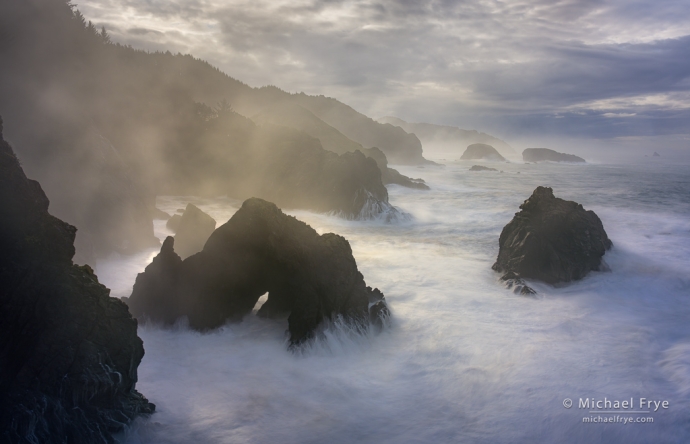
Sunlight breaking through clouds and fog, Oregon Coast. During our workshop we waited out a brief-but-heavy rain shower by sheltering underneath a dense tree canopy. After we emerged clouds blocked the sun for awhile, but eventually sunlight broke through and backlit the wave-generated mist for a few beautiful minutes. 28mm, 3 seconds at f/11, ISO 100, ND filter.
Sometimes I’m out with my camera on a clear, sunny day, and a passerby says, “What a beautiful day for photography!” I just smile and agree; there’s no point in discussing the finer points of landscape photography with a passing stranger.
And of course you can make good photographs on clear, sunny days. Those conditions are perfect for many subjects and scenes. But landscapes are usually more interesting and photogenic with clouds, fog, mist, snow, or rain – and the light that weather helps create, like sunbeams, rainbows, dappled light, colorful sunsets, and so on.
(more…)
by Michael Frye | Nov 28, 2024 | Announcements
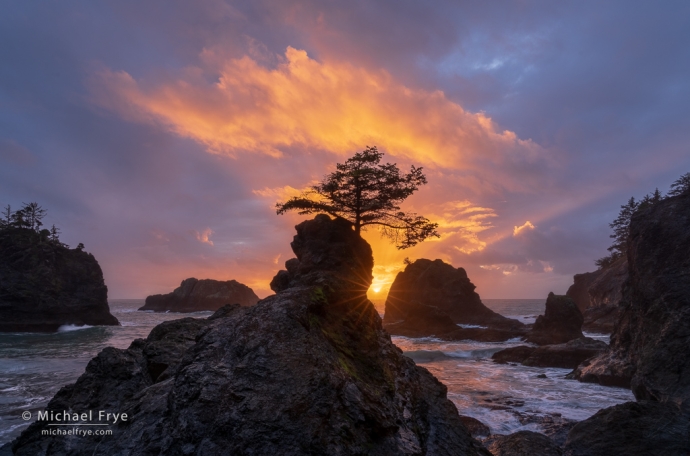
Sun setting behind a small tree, Oregon Coast. I’m grateful I get to see so many beautiful moments like this.
It’s Thanksgiving Day here in the United States. Whether or not you celebrate Thanksgiving in your part of the world, I think there’s value in gratitude – to giving thanks for all the things we have to be grateful for. We really should do that every day, but it’s good to have that reminder once a year.
(more…)
by Michael Frye | Nov 24, 2024 | Light and Weather
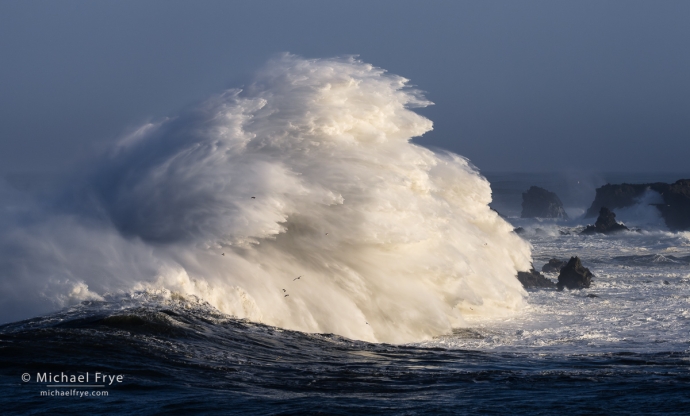
Breaking wave, Oregon Coast (from last Wednesday morning). This is one of the largest wave splashes I’ve ever seen. Note the gulls in front of the wave (you can click on this to see it larger). 192mm, 1/500 sec. at f/16, ISO 640.
After our Oregon Coast workshop Claudia and I hung around for a few more days, since we love this area, and the weather models were showing that more big waves were possible.
And I’m glad we stayed, as we did see some large waves last Monday, and then even bigger ones on Wednesday, after the “bomb cyclone” brought winds and heavy rain to the area on Tuesday and Tuesday night.
(more…)
by Michael Frye | Nov 17, 2024 | Light and Weather, Travels and Stories
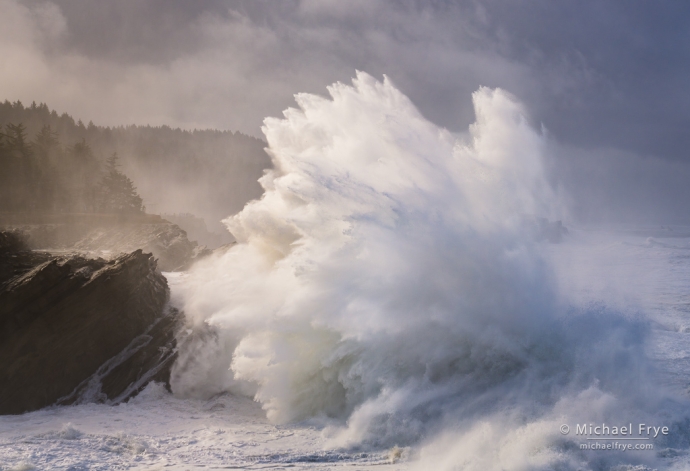
Crashing wave on a foggy morning, Oregon Coast
We just finished another edition of our Oregon Coast workshop, and once again had a great time. We had a really nice group of people, which always makes it more fun for everyone. And we encountered some wonderfully stormy weather.
The forecasts for the workshop showed a series of storms, and rain every day. But that didn’t mean nonstop rain. I knew there would be breaks, and those breaks could generate some interesting light.
(more…)
by Michael Frye | Nov 7, 2024 | Light and Weather, Travels and Stories
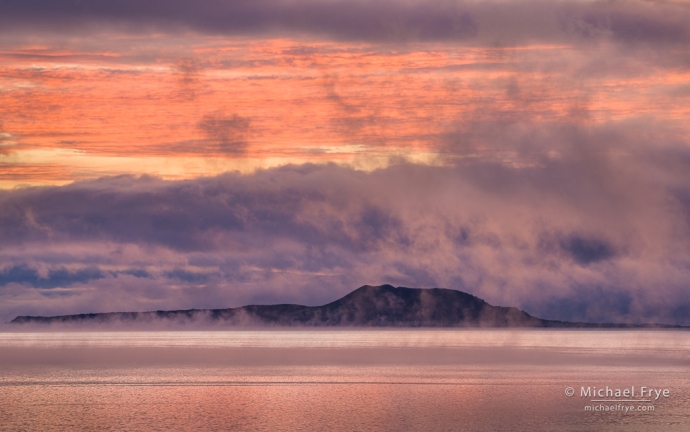
Fog and Negit Island, sunrise, Mono Lake, California
On our way home from Montana last month, Claudia and I stopped for the night in Lee Vining (near Mono Lake, just east of Yosemite). We met our friends Charlotte and Gary Gibb there, and had dinner with them at the Whoa Nellie Deli.
It was raining – the first significant weather we’d encountered on our whole trip. Then, just before sunset, the rain stopped, and we saw signs of clearing, so we rushed out to the shore of Mono Lake to catch the sunset. While we didn’t see the sun breaking through, we caught a nice sunset glow over the lake:
(more…)

















